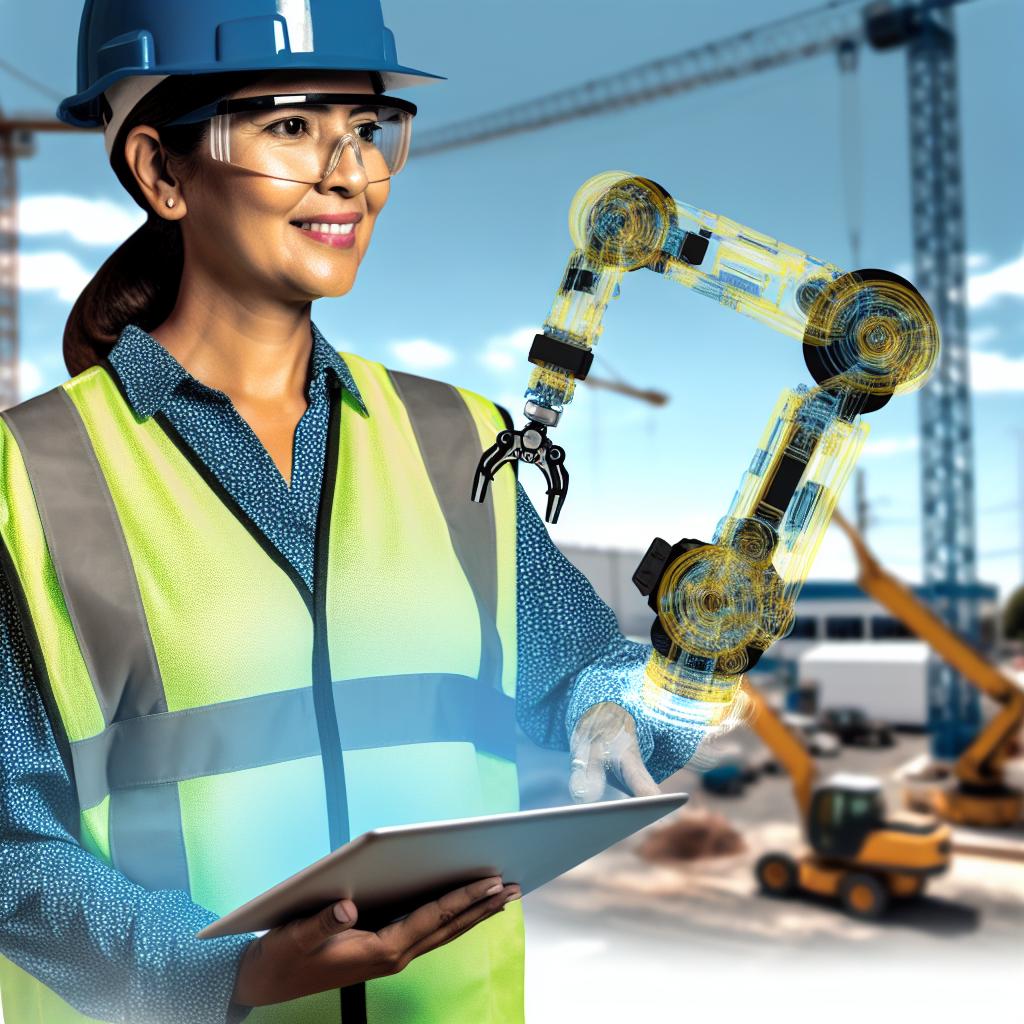With the rapid evolution of technology in construction, the industry is constantly adapting to new methods and tools.
Sustainability and green building practices have taken the forefront in construction, impacting how projects are designed and executed.
There is a noticeable shift towards prefabrication and modular construction, allowing for faster and more efficient project delivery.
As the construction industry continues to evolve, it is essential to leverage technology to increase efficiency in construction projects.
By embracing innovative tools and strategies, construction companies can streamline processes, improve accuracy, and ultimately achieve better results.
Utilizing Building Information Modeling (BIM)
- BIM is a digital representation of a building’s physical and functional characteristics.
- It allows construction professionals to collaborate seamlessly and detect clashes before construction begins.
- By using BIM, project teams can visualize the entire project lifecycle, from design to maintenance.
Exploring the Benefits of Drones and Virtual Reality
- Drones provide a bird’s eye view of construction sites, enabling better monitoring and progress tracking.
- Virtual reality enables stakeholders to experience the project in a simulated environment, enhancing project visualization.
- Both technologies improve safety, reduce costs, and enhance decision-making throughout the construction process.
Highlighting the Importance of Construction Management Software
- Construction management software streamlines project planning, scheduling, and communication.
- It centralizes project data, improves collaboration, and enhances project transparency.
- Adopting construction management software boosts productivity, reduces errors, and optimizes project performance.
Technology is crucial for the construction industry’s adaptation to changing trends. It helps companies remain competitive in today’s market.
By leveraging tools like BIM, drones, virtual reality, and construction management software, companies can improve efficiency, accuracy, and decision-making.
This ultimately leads to successful construction projects.
Embracing sustainability in construction practices
The construction industry is experiencing a shift towards more sustainable practices to reduce environmental impact.
This shift is necessary to meet the growing demand for eco-friendly buildings.
This trend is driven by various factors such as climate change, resource depletion, and consumer awareness.
Growing Demand for Eco-Friendly Materials
- Builders and developers are increasingly opting for eco-friendly materials like bamboo, recycled steel, and reclaimed wood.
- These materials are not only sustainable but also offer durability and aesthetic appeal.
- Manufacturers are also responding to the demand by producing eco-friendly alternatives to traditional construction materials.
Use of Renewable Energy Sources in Construction
- Renewable energy sources such as solar panels, wind turbines, and geothermal heating systems are being integrated into construction projects.
- These energy-efficient solutions lower operational costs and decrease carbon emissions.
- Government incentives and regulations are encouraging the use of renewable energy in construction.
Importance of Reducing Waste and Promoting Recycling
- Construction generates a significant amount of waste, including materials like concrete, wood, and metals that can be recycled.
- Implementing waste reduction strategies can minimize the environmental footprint of construction companies.
- Recycling construction waste conserves natural resources and reduces landfill waste and emissions.
Embracing sustainability in construction practices is beneficial for the environment and the long-term viability of the industry.
By incorporating eco-friendly materials, utilizing renewable energy sources, and reducing waste, construction companies can lead the way towards a more sustainable future.
See Related Content: Health and Fitness Tips for Masons on the Job
Benefits of Prefabricated Building Components
Prefabrication has been gaining popularity in the construction industry due to its numerous benefits.
One of the main advantages is the time-saving factor.
Prefabricated building components are manufactured in a controlled environment, which reduces construction time significantly.
Additionally, prefabrication can lead to cost savings as it minimizes waste and allows for better cost estimation.
Quality control is also improved because the components are fabricated in a factory setting where strict standards can be maintained.
Another benefit of prefabricated building components is the potential for increased sustainability.
Transform Your Career Today
Unlock a personalized career strategy that drives real results. Get tailored advice and a roadmap designed just for you.
Start NowBy reducing waste and energy consumption during the construction process, prefabrication can help reduce the environmental impact of a project.
Challenges of Implementing Modular Construction
While modular construction offers many benefits, there are also several challenges that come with its implementation.
One major challenge is transportation and logistics.
Modular units need to be transported to the construction site, which can be costly and require careful coordination.
Another challenge is design limitations.
Since modular units are prefabricated off-site, there are limitations to the design flexibility compared to traditional construction methods.
Designers must work within the constraints of modular components, which can be a challenge for complex projects.
Additionally, regulatory requirements and building codes can pose challenges for modular construction.
Ensuring that modular units meet all safety and quality standards can sometimes be more complex than with traditional construction methods.
Successful Projects Utilizing Prefabrication Techniques
- One Dalton Street, Boston: This luxury skyscraper was constructed using prefabricated bathroom pods, which helped streamline the construction process and reduce costs.
- Marriott Hotel, New York City: The modular construction of this hotel allowed for faster completion and reduced disturbance to the surrounding area.
- i360 Observation Tower, Brighton: The observation tower in the UK was built using prefabricated components, which accelerated the construction timeline and minimized on-site disruptions.
These successful projects demonstrate the effectiveness of prefabrication techniques in delivering high-quality buildings efficiently and cost-effectively.
Adapting to the rise of prefabrication and modular construction in the industry requires a shift in traditional construction methods.
By understanding the benefits, overcoming challenges, and learning from successful projects, construction companies can embrace these innovative techniques to improve efficiency, reduce costs, and deliver better-quality buildings to meet the evolving needs of modern construction.
Explore Further: Ironworker Safety Regulations and Compliance Standards
Addressing the skills gap in the construction industry
In today’s rapidly evolving construction industry, there is a growing concern about the skills gap that exists among construction workers.
The gap arises from the lack of training and education in emerging construction trends.
It is crucial for companies to invest in developing their workforce.
Discuss the need for training and education in emerging construction trends
- Technology advancements in construction require workers to be well-versed in the latest tools and techniques.
- Ongoing training programs help employees stay up-to-date with industry standards and best practices.
- Investing in education for employees ensures a competitive edge and increased efficiency on the job site.
- Training in sustainable construction practices is essential for meeting green building requirements and regulations.
Highlight the importance of attracting young talent to the industry
- Recruiting young professionals brings fresh perspectives and innovative ideas to the construction field.
- A youthful workforce can adapt quickly to changing technologies and contribute to the company’s growth.
- Engaging with schools and vocational programs helps in promoting construction careers to the younger generation.
- Mentoring programs can guide young talent and create a pathway for long-term success in the industry.
Explore the opportunities for career growth in construction
- Construction offers a diverse range of career paths, from project management to skilled trades.
- Continuous skill development and certifications open doors to higher-paying positions in the industry.
- Leadership roles in construction provide opportunities for individuals to manage projects and teams.
- With experience, construction professionals can start their businesses or consult in the industry.
Addressing the skills gap in the construction industry requires a multi-faceted approach.
This approach involves training and education in emerging trends, attracting young talent to the field, and highlighting various career growth opportunities available.
By investing in the workforce and promoting a culture of continuous learning, construction companies can adapt to changing trends and remain competitive in the industry.
Showcase Your Business Today
Reach thousands of readers actively exploring professional services. Publish your business profile and grow your audience now.
Publish NowLearn More: How Glaziers Contribute to Energy-Efficient Buildings

Importance of communication and collaboration in construction projects
Effective communication is vital in construction projects to ensure all stakeholders are on the same page.
Collaboration promotes better problem-solving, efficiency, and overall project success.
Regular meetings and updates help to address any issues promptly and keep the project on track.
Benefits of partnering with innovative suppliers and subcontractors
Innovative suppliers and subcontractors bring fresh ideas and solutions to the project.
They can offer new technologies and materials that can improve efficiency and quality.
Collaborating with innovative partners can give a competitive edge and set your project apart.
Role of project management in adapting to changing trends
Project management plays a crucial role in identifying and responding to changing trends.
Effective project managers anticipate challenges and proactively seek solutions to overcome them.
They must stay informed about industry developments and implement changes to stay ahead.
Adaptability and flexibility are key qualities for project managers to navigate changing trends successfully.
See Related Content: The Future of Construction Management
Importance of Adapting to Construction Trends
Adapting to changing trends in construction is crucial for staying competitive in the industry.
By embracing new technologies and methods, professionals can improve efficiency and quality.
It is essential to prioritize learning and development to keep up with the evolving landscape of construction.
Staying adaptable allows companies to offer innovative solutions and meet the changing needs of clients.
As the construction industry continues to evolve, it is vital for professionals to embrace change and seek opportunities for growth.
By staying informed and open to new trends, individuals can thrive in an ever-changing environment.
Ultimately, staying adaptable and evolving with the changing trends in construction is key to long-term success in the industry.
By continuously learning and improving, professionals can stay ahead of the curve and drive innovation in the field.
I encourage readers to remain proactive in their learning and development, embracing change and seeking opportunities for growth.
By staying adaptable and open-minded, professionals can navigate the shifting landscape of construction with confidence and success.
Additional Resources
Changes in the American workplace
Generative AI and the future of work in America | McKinsey
[E-Books for Sale]
The Big Book of 500 High-Paying Jobs in America: Unlock Your Earning Potential
$19.99 • 500 High-Paying Jobs • 330 pages
Explore 500 high-paying jobs in America and learn how to boost your career, earn more, and achieve success!
See All 500 High-Paying Jobs of this E-Book
1001 Professions Without a Degree: High-Paying American Jobs You Can Start Now
$19.99 • 1001 Professions Without a Degree • 174 pages
Discover 1001 high-paying jobs without a degree! Unlock career tips, skills, and success strategies for just $19.99!




